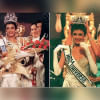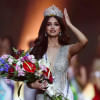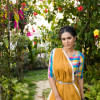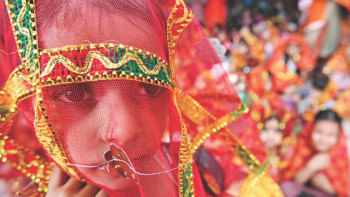How Methila made Bangladeshi tradition shine on the global stage

When Tangia Zaman Methila stepped onto the Miss Universe 2025 platform, she wasn't just presenting herself as a contestant — she was carrying centuries of cultural heritage stitched into every inch of her attire. Wearing a handwoven white Jamdani saree from Thread, and adorned in intricate handcrafted jewellery by 6 Yards Story, the ensemble was more than just fashion — it was a statement.

A saree woven with intent
When the Miss Universe Bangladesh team first approached Syeda Sadia Afrina, founder of the slow-fashion label Thread, with the idea of designing the national costume, the timeline was tight — just four months.
"At first I was sceptical," Afrina admitted, "but I convinced myself to take it on when I realised the opportunity it presented — to bring Bangladeshi heritage to a world-class platform."
Within a week, she shared a pencil sketch of the design with the organisers. "They believed in me and created a comfortable environment to work collaboratively," she added. "That made everything easier for me and team Thread. Together, we created this masterpiece on time."
The saree, handwoven with traditional khadi cotton and delicate golden zari, is covered in motifs of the shapla, Bangladesh's national flower. The choice was intentional.
"Shapla symbolises purity, resilience, and the calm beauty of rural Bangladesh," Afrina explained. "Even when it grows from muddy waters, it blooms clean and graceful. That's the message — we rise above, we adapt, we continue."
The base colour, a serene white, also carried meaning. "White is seen as a sign of peace and harmony," Afrina said. "These are values that lie at the heart of our cultural identity."
The jewellery as armour
The visual impact didn't stop at the Jamdani. What turned heads was the jewellery — pieces that didn't just accessorise, but structured the entire look. Designed by Lora Khan of 6 Yards Story, the jewellery formed a full blouse-like bodice, shoulder to waist, glowing under stage lights like modern armour rooted in tradition.
"It wasn't technically a blouse," Lora explains. "It was jewellery designed to mimic the form of a blouse, fixed over a green fabric so that a faint shadow effect could peek through — creating depth and drama."
The choice of motifs was no coincidence either. "Methila wanted to bring out Bangladesh's heritage through her look," Khan shares. "So, we centred the entire jewellery concept around the water lily. It appeared on the baju (armlet), the chabir gochha (ornamental keychain), even the tayra (forehead piece)."
Khan brought together a team of 12 artisans, working continuously for two months to handcraft the intricate ensemble. The elements included ratanchur, jhumkas, golap bala, tayra, and even a bichha — all rendered in a design language that was unmistakably Bangladeshi.
"The idea was that the whole blouse would look like one single piece — almost like gold armour," Lora recalls. "We drew from traditional bridal ornaments, but repurposed them with modern silhouettes, keeping it regal yet rooted."
And the result? A look that felt powerful without being performative. It didn't just "represent" culture. It embodied it.

Trust and creative freedom
One key reason the outcome felt so cohesive was the creative freedom the artisans were granted. "Methila trusted us completely," Lora recalls. "From the first meeting, she said, 'Whatever you make, I'll wear.' No revisions, no interference. That level of faith allowed us to bring our best work."
That trust, Afrina adds, speaks to the larger message: "When we respect our artisans and trust their expertise, they will rise to the occasion. That's what you saw on stage."
Beyond beauty pageants
What makes this story stand out is its intentionality. This was not a token nod to culture. It was an effort to elevate it — to turn indigenous art forms into aspirational statements on a global platform.
For Afrina, the experience felt full circle. "Our weavers often work anonymously, away from the spotlight. But that night, they were part of the main story. And that's what matters."
For Khan, the moment is still sinking in. "I haven't processed it fully yet," she says. "But I'm proud. This wasn't just my work being shown — it was our country's soul, stitched and sculpted."
In a world saturated with synthetic fashion and fast-paced trends, what Tangia Zaman Methila wore was timeless — a reminder that the most powerful style statements are made not in excess, but in meaning.
Photo: Rony Rezaul

 For all latest news, follow The Daily Star's Google News channel.
For all latest news, follow The Daily Star's Google News channel. 








Comments